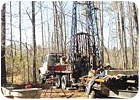
Rarely do you find anyone in the construction business who hasn't been victimized by “shrinkage” of tools, equipment and inventory. Most estimates peg construction theft to be a $1 billion “industry.” Pilferage is estimated to add a percentage point or two to the cost of new homes and small commercial buildings.
Construction site thieves will steal anything and everything, from the lowliest hand tools to the largest mechanized equipment. The latter tends to be attractive to rings of sophisticated thieves who take advantage of jobsite security lapses. They know how to market hot equipment that honest contractors normally wouldn't want any part of - although they sometimes end up buying stolen goods inadvertently. Rogues who steal big-ticket items such as drilling rigs are the construction industry's version of jewel thieves.
Penny-ante crooks by comparison are attracted to hand tools and materials that are more easily stolen and sold. We'll deal with these blue-collar crooks in the second of this two-part article.

White-color Hanky-panky
First, I want to draw attention to a white-collar crime that represents an even bigger threat to small businesses. That is embezzlement, usually done by a trusted bookkeeper. Small companies are more vulnerable than large corporations, where bookkeeping and accounting get divided among numerous workers in large departments. Big companies have plenty of crosschecks, audits and division of responsibilities that make it hard for individuals to get away with hanky-panky.In small companies, a single individual often has control over a company's payables and receivables. Frequently, this person also has check-writing authority. Small construction firms are especially vulnerable, because so many companies are run by hands-on contractors with a lot of savvy in their craft but who pay little attention to office operations. Many are only too happy to delegate the bookkeeping chores to someone who is good with numbers and seems to enjoy dreary paperwork.
One survey of certified public accountants by the Institute of Internal Auditors (Auditors Inc.) found that as many as 40 percent of small businesses may suffer embezzlement losses, small or large. Another study I came across said that the average amount embezzled from small businesses was more than $127,000.
Exact data is hard to track, however, since many cases go unreported. The Auditors Inc. survey indicated that only 2 percent report the crime. Most owners are too embarrassed to report it, and they worry it will destroy their credit rating or bonding capacity if word gets out. Prosecution can be costly and time-consuming and not worth the trouble if the amounts stolen are not huge. Most commonly, they simply fire the bookkeeper who often goes on to do the same thing in another job.
Off the top of my head, I can recall hearing of three construction industry firms that were ripped off to the tune of six- and even seven-figure amounts over a period of years via embezzlement. In all cases, the embezzler was a trusted employee of long tenure. In all cases, the business owners were focused on the operational side of the business and didn't want to be bothered with financial details as long as bills seemed to get paid and paychecks didn't bounce. In all cases, it came as a devastating shock to learn that hundreds of thousands of dollars - in one case, several million bucks - had been slowly but steadily siphoned away.
These were extreme cases. The embezzlers were clever and deliberate. The multi-million dollar episode involved a problem gambler who was prosecuted and convicted, but only after she had squandered most of the stolen money. The company was able to collect only a little back from her.
Most pilferage is on a smaller scale, which makes it hard to detect. Typically, it involves phony invoices or siphoned payments of only a few hundred dollars or less. The amounts don't raise many eyebrows, although the total adds up over time. Often, the employee rationalizes stealing from the company because s/he feels underpaid. It often begins with minor amounts, sometimes even with the intention of paying the company back. But as soon as an employee realizes s/he can get away with a little without getting caught, the tendency is to take more chances and bump up the amounts.

Precautions to Take
It's not my intention to instill paranoia and get all of you staring daggers at the office manager who's been working for you for years and may be as much a friend as an employee. I'm sure most of these people fully deserve the trust you place in them. Yet, it's useful to keep in mind something the leaders of the United States and Soviet Union used to say when asked if they trusted each other to adhere to nuclear arms agreements - “trust - but verify.”
Most employee fraud can be prevented by following some simple rules and procedures. Here are some of the guidelines:
- An ounce of prevention is worth a pound of cure. Be diligent when hiring for positions that involve company finances. Be wary of job applications and resumés that show frequent job changes, and be sure to ask for and check references thoroughly. Don't make just one phone call for a background check. Call all former employers, whether they are cited as references or not.
- Don't delegate check-signing and cash disbursement responsibilities. Even if you are a “hands-off” owner, give yourself the job of examining all canceled checks and bank statements, and make sure you understand what every check was for. If it's too much work for you to handle, at least make sure that employees charged with writing or depositing checks are different than the ones who balance the checkbook.
- Keep an eye out for payments made to unfamiliar vendors. Find out who they are and what they're getting paid for. Ask yourself if the amount and frequency of the payments seem reasonable.
- Have checks sent to a post office box rather than a mailing address, and limit access to the P.O. box.
- Make sure no one person handles transactions from beginning to end. For instance, separate money collection duties from accounts receivable, and purchasing from accounts payable.
- Personally investigate customer complaints about double billing, as well as slow collections and inventory shortages. They could be innocent mistakes, but they also could be warning signs of embezzlement.
- Check out employees who seem to live beyond their means. When the office manager drives a bigger car and has a fancier wardrobe than the owner, it should raise a red flag. Be especially wary of those with a fondness for casinos and racetracks.
- Keep an eye out for employees with financial and personal problems. Let them know you're aware of their situation and offer to help if possible, but also keep them away from tempting opportunities.
- Workaholism is another warning sign. Embezzlers frequently work late and on weekends and are reluctant to take vacations out of fear that someone else may look at the books and discover their schemes.
Employers who get victimized by embezzlement often find it even more devastating emotionally than financially, because it almost always involves someone they trusted and were close to. I heard of one embezzlement scheme that started to unravel when the owner of a company attended the wedding of a key employee's daughter. The company owner wondered how the employee could afford such a lavish celebration.
Next month, we'll deal with some dos and don'ts to avoid tool, equipment and materials shrinkage.

Report Abusive Comment